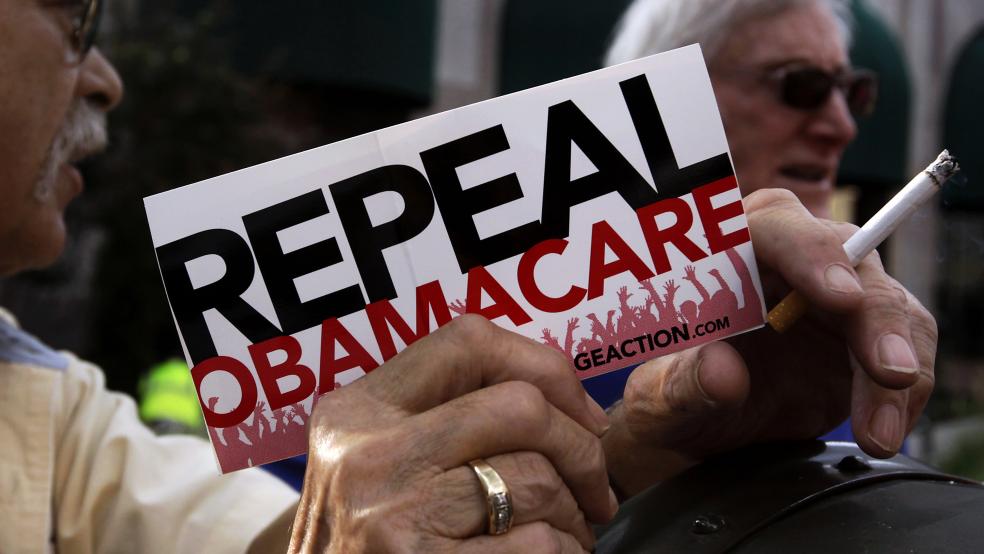President Donald Trump declared during his first address to a joint session of Congress Tuesday night that the repeal and replacement of the Affordable Care Act was just around the corner. But this time he urged recalcitrant Democrats to join with Republicans in dismantling what he described as an “imploding” national health insurance program.
“I am calling on this Congress to repeal and replace Obamacare with reforms that expand choice, increase access, lower costs, and at the same time, provide better healthcare,” Trump said to the cheers and howls of GOP lawmakers in the House chamber while Democratic Senate and House members sat impassively. “Obamacare is collapsing – and we must act decisively to protect all Americans.”
Related: Boehner ‘Started Laughing’ When Republicans Vowed to Replace Obamacare
Trump waited nearly 40 minutes into his lengthy speech before first broaching what many think is the most urgent challenge facing the White House and the Republican-controlled Congress this year – and one that carries the biggest political risks for the GOP if the whole repeal and replace venture blows up in their face.
Lawmakers just returned from a week-long recess, and many Republicans were shaken by angry constituent protests against repealing Obamacare during town hall meetings and street demonstrations. Polls also indicate that Obamacare is growing in popularity among voters just as the Republicans are pressing to repeal it this spring.
With growing signs that neither Trump nor congressional Republican leaders are anywhere near agreement on a consensus replacement plan that doesn’t strip millions of Americans of their health insurance or expanded Medicaid coverage, GOP lawmakers were eager last night to hear a rallying cry from the new president.
“Mandating every American to buy government-approved health insurance was never the right solution for America,” Trump said. “The way to make health insurance available to everyone is to lower the cost of health insurance, and that is what we will do.”
Related: Americans Sour on Trump and Congress as Replacing Obamacare Flounders
But if the Republicans in the chamber or watching on television were hoping for a little more clarity as to what a package of Trumpcare reforms might look like – and how the various
proposals would interact so that millions of Americans don’t lose their health care insurance in the transition – they were in for a disappointment.
Trump indeed outlined five or six bedrock “principles” for the replacement legislation. But most of them were familiar ideas left over from the presidential campaign or newer, more controversial ideas -- but without any meat on the bone.
First, he would preserve the Obamacare rule preventing insurers from discriminating against people with pre-existing health conditions. That idea, along with another Obamacare feature allowing children to remain on their parents’ health insurance policies until they turn age 26, have both been met with universal support on Capitol Hill.
Second, Trump said he favors granting tax credits to help consumers purchase health insurance policies of their choice, although he doesn’t say what kind of credit. House Speaker Paul Ryan (R-WI) and other House GOP leaders have pushed the idea of a refundable tax credit based on age, with older and wealthier Americans getting the lion’s share of the benefit. However, many conservatives have opposed that approach, saying that it is too close to the current tax subsidy in Obamacare and that its adoption would create a new entitlement.
Related: Republicans Risk Passing New Health Bill by Defunding Planned Parenthood
Trump also favors expanded tax-exempt Health Savings Accounts to help consumers cover some of their medical costs, but that’s a no brainer and has become boilerplate for most of the replacement plans making the rounds.
Third, Trump signaled support for changes in the Medicaid program to “give our great state governors the resources and flexibility they need with Medicaid to make sure no one is left out.” This is an important point because Trump once said he would protect Medicaid, along with other entitlement programs, and now he is embracing an approach that likely would lead to converting Medicaid to state block grants.
While the block grant or per capita payment approach would result in billions of dollars of savings to the federal government in years to come, it would likely force states to sharply reducing coverage and benefits to low-income Americans, which costs $6,833 per person annually, on average. The idea is highly controversial and has been strongly opposed by some Republican governors as well as the Democrats.
Related: A First for Obamacare: Majority of Americans Now Support It
The last three principles are proposals Trump campaigned on: Tort reform to protect doctors from excessive and costly litigation; more freedom for major insurance companies to sell policies across state lines and efforts to “bring down the artificially high price of drugs.”
As Politico reported, Republicans lack consensus on some of the most basic questions, such as “how much to spend to reshape the health system, how much financial help to give Americans to buy insurance and how to come up with the money to pay for it all.”
Trump at one time boasted that he would repeal and replace Obamacare “simultaneously” shortly after he took office, but his repeated promises to unveil a comprehensive plan that would provide less expensive and better quality coverage than Obamacare have all fallen through. During his meeting with the National Governors Association at the White House on Monday, Trump acknowledged, “Now, I have to tell you, it’s an unbelievably complex subject. Nobody knew that healthcare could be so complicated.”





